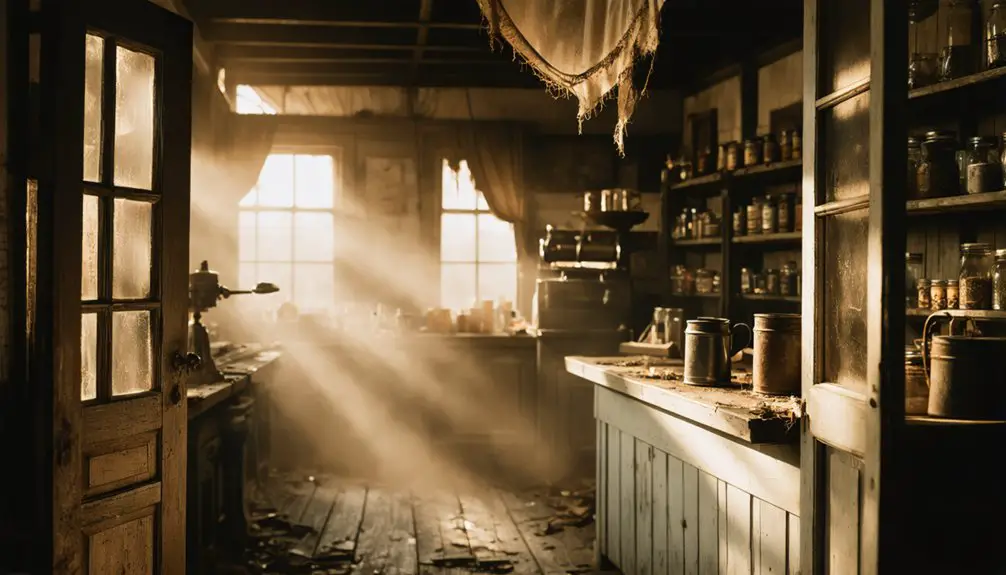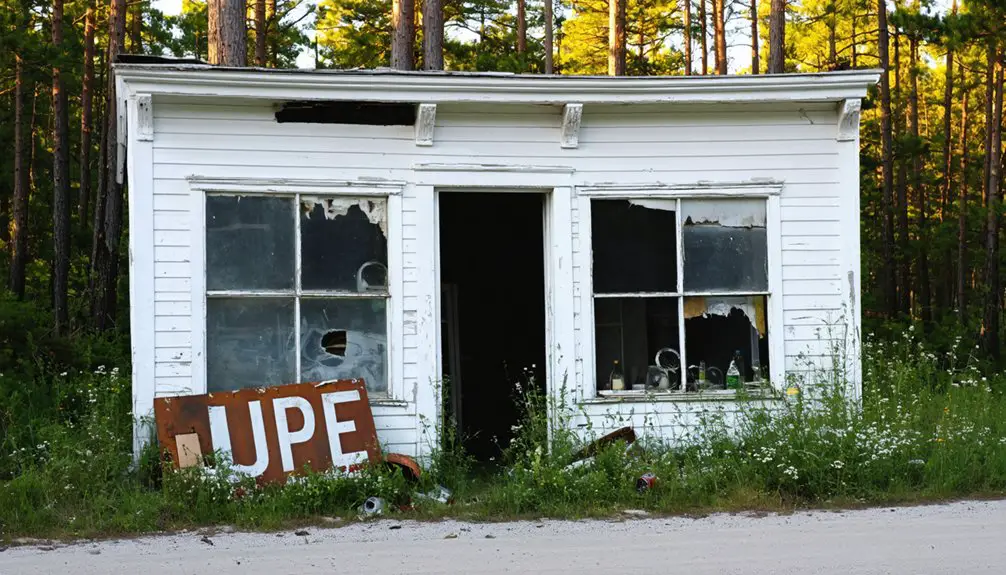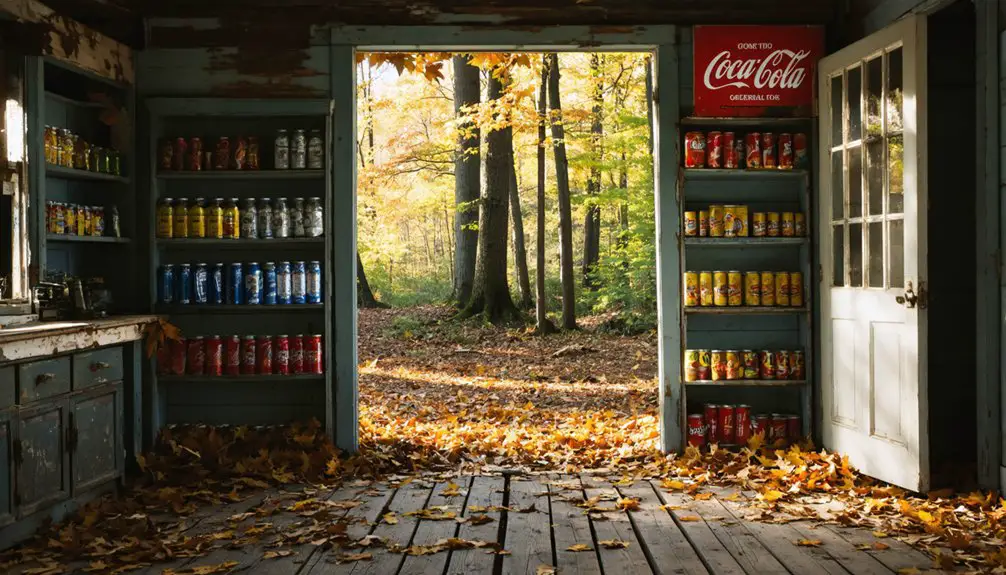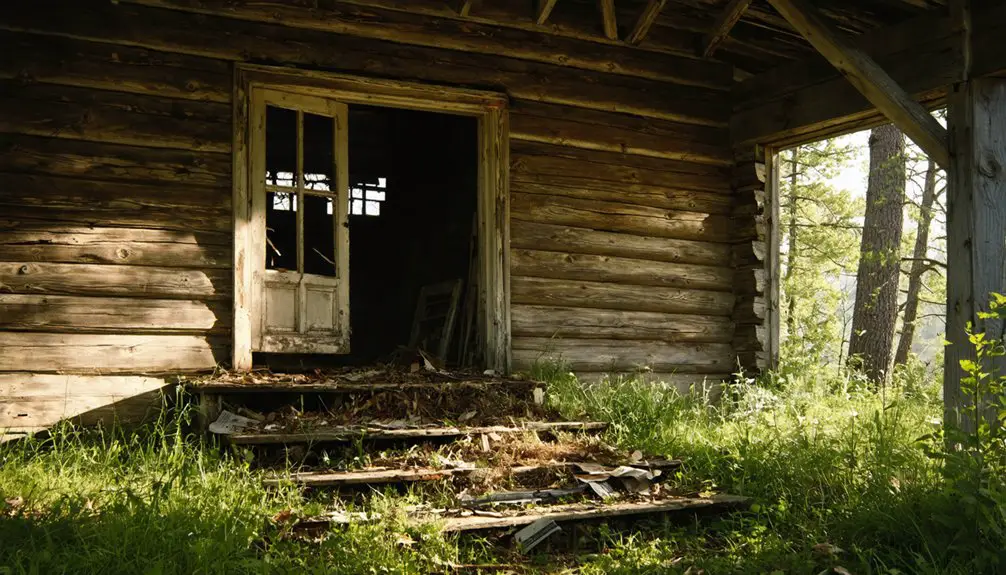You’ll find Davidson, Maine’s most complete ghost town hidden in the wilderness, founded in 1901 by Ora Gilpatrick as a lumber community. The town thrived around its sawmill and clothespin factory, with wooden sidewalks connecting homes, a general store, and railway station. After Gilpatrick sold the township in 1929, Davidson fell into decline. Today, only scattered foundations, metal scraps, and old chimneys tell the story of this once-bustling industrial settlement.
Key Takeaways
- Davidson was founded in 1901 by Ora Gilpatrick as a lumber town, centered around a sawmill and clothespin factory powered by water.
- The town flourished with wooden sidewalks, boarding houses, a general store, and railway connections for timber transportation.
- Economic decline began after Gilpatrick’s 1929 sale, leading to business closures, mass unemployment, and resident exodus.
- Infrastructure deteriorated with impassable roads and abandoned rail lines, while buildings succumbed to fire and decay during the Great Depression.
- Today, only foundations, metal scraps, and occasional chimneys remain visible as nature reclaims the former thriving logging community.
The Birth of a Lumber Town
When Ora Gilpatrick established Davidson in 1901, he envisioned more than just another Maine settlement – he saw the potential for a thriving lumber town. As a successful businessman from Houlton with deep lumber heritage passed down from his father, Gilpatrick owned the entire township and strategically positioned it west of Stacyville.
During the harsh winters, frozen ground conditions made transporting logs much easier for the Davidson operations. You’ll find that his vision quickly materialized as he built the town’s foundation, including homes for himself and his sons. The community’s beating heart became its sawmill and clothespin factory, while a network of supporting businesses sprouted up – from the general store to the blacksmith shop. Similar to the ten-hour workday implemented in other lumber operations of the era, Davidson’s mills maintained strict operational schedules.
A B&A Railway station connected Davidson to broader markets, embodying the community resilience that would define early 20th-century Maine lumber towns.
Industrial Heartbeat: Mills and Manufacturing
At the core of Davidson’s economic engine stood two major industrial facilities: the sawmill and the distinctive white clothespin factory. You’d find these interconnected operations linked by rail lines, with a cone-shaped waste burner between them handling manufacturing scraps.
The clothespin mill’s industrial significance was evident in its role as a major employer of both men and women by 1908. Like many industrial operations of the era, the mill relied on water-powered energy from nearby rivers to drive its machinery. The mill’s success mirrored Maine’s broader industrial growth, with the state becoming home to the world’s largest paper and wood processing facilities.
By 1908, the clothespin factory had become a vital economic force, breaking gender barriers by employing both men and women.
The economic impact rippled through Davidson as Ora Gilpatrick’s venture capitalized on the region’s natural resources and B&A Railway access. The factory complex included a boiler room for power generation, while the adjacent sawmill processed raw timber into valuable products.
This industrial backbone supported the town’s growth, providing steady employment and attracting essential services that transformed Davidson into a thriving community.
Daily Life in Early Davidson

Life in early Davidson revolved around the steady hum of its industrial core, where residents navigated wooden sidewalks between company-owned homes and the bustling clothespin factory.
Like many Maine ghost towns where workers paid rent to owners, Davidson’s residents lived under the careful watch of company management while trying to build their community.
You’d find clear community roles and gender dynamics woven into the town’s fabric. While men and women both worked at the factory and sawmill, they’d retire to separate boarding houses if single.
The town’s heartbeat synced with factory whistles and train schedules, yet social life flourished. You could catch the latest films or join community dances in the entertainment hall, worship at the local church, or pick up supplies at the general store.
The dairy operation, post office, and blacksmith shop kept daily routines running smoothly, while the town hall served as a center for civic engagement.
Ora Gilpatrick established the town in 1901 after purchasing the entire township, setting the foundation for Davidson’s brief but vibrant existence.
Railway’s Role in Town Development
You’ll find Davidson’s transformation into a bustling transportation hub began with the Maine Central Railroad’s strategic expansion through Danville Junction in the mid-1800s.
The railway’s presence sparked rapid commercial growth as Davidson became a vital waypoint for timber and paper products moving between northern Maine’s industries and Portland’s markets. During this growth period, four trains daily connected Portland to Waterville, strengthening the region’s economic corridors. The railroad reached its highest point of operations when it expanded to 1,358 miles of track during World War I.
The B&A station served as the town’s lifeline, handling freight operations and passenger services that connected Davidson to the broader New England rail network until the town’s eventual decline.
Transportation Hub Development
During the mid-nineteenth century, Davidson emerged as a vital transportation hub when Maine’s expanding railroad network reached the town, transforming it from a remote settlement into a bustling center of commerce.
You’d have found impressive railroad connections there, including multiple rail routes that converged at Davidson’s central station. The transportation evolution brought essential infrastructure: a prominent passenger depot, car houses for maintaining rolling stock, and distinctive octagonal crossing shanties that monitored train movements. The town’s development paralleled the growth of Maine Central Railroad, which formed in 1862 through key railroad mergers.
The rail yard became the town’s beating heart, where you could witness the daily loading of freight and boarding of passengers. The rail network’s design featured narrow gauge tracks that allowed trains to efficiently navigate the region’s challenging terrain. The station area attracted local businesses, creating a vibrant commercial district that served both travelers and residents alike.
Rail Commerce Impact
While standard gauge railroads dominated most of Maine’s larger cities, Davidson’s economic fortunes rode on the unique two-foot narrow gauge rail system that served the region’s remote communities.
You’ll find that this rail infrastructure, though limited in capacity, initially proved essential to Davidson’s growth by enabling the export of timber and paper products to broader markets at just one-third the construction cost of standard lines.
Despite these early advantages, you’d discover that Davidson’s economic sustainability ultimately suffered from the narrow gauge’s limitations.
The smaller equipment and slower speeds couldn’t match the volume of standard gauge competitors.
When the Maine Central Railroad began consolidating regional transport networks and trucking emerged as a viable alternative, Davidson’s restricted rail capacity left it increasingly isolated, contributing to its eventual decline into a ghost town.
B&A Station Operations
As the commercial heart of Davidson, the Bangor and Aroostook (B&A) Railway station established itself as more than just a transportation hub – it became the town’s economic lifeline.
You’d find the station bustling with activity as specialized boxcars, equipped with wood stoves and sheathing paper, transported local lumber and agricultural products throughout Maine’s northern regions.
The B&A station’s operations evolved from steam to diesel power, while maintaining essential infrastructure like turntables to service locomotives.
You could’ve caught a daily train for just 35 cents in 1936, sharing the rails with freight cars that carried Davidson’s manufactured goods, including clothespins, to distant markets.
The station anchored crucial community services, from the post office to boarding houses, cementing its role as Davidson’s commercial nucleus.
Community Spaces and Social Gatherings
The social fabric of Davidson, Maine revolved around several key gathering spaces that united the community. You’d find locals congregating at the town hall for civic meetings, while the dedicated entertainment building hosted movies and dances that brought everyone together.
The general store wasn’t just for supplies – it served as a daily meeting spot where community engagement flourished.
- The town hall anchored civic life and public discourse
- Two gender-separated boarding houses fostered tight-knit residential bonds
- The church provided both spiritual guidance and social connections
Whether you were catching up with neighbors on the wooden sidewalks or sharing news at the post office, Davidson’s communal spaces encouraged constant interaction.
Even the blacksmith shop and dairy became natural gathering points where social bonds strengthened through daily commerce and conversation.
Working Life at the Clothespin Factory

Inside Davidson’s bustling clothespin factory, you’d find a diverse workforce of local men and women operating at remarkable capacity, producing hundreds of thousands of pins daily.
You’d see women managing loading docks and raw materials near the log ponds, while men typically operated the heavy machinery powered by a massive steam engine system.
The factory workforce maintained impressive production efficiency, processing about 15,000 feet of logs each day.
Walking through the facility, you’d witness workers shaping pins, handling raw materials, and loading finished products onto boxcars for shipment.
The factory’s integrated infrastructure included footbridges for commuting workers and separate boarding houses for men and women who’d moved to Davidson for employment.
You’d smell the steam from the boilers and hear the constant hum of machinery throughout your workday.
The Great Sale and Town’s Decline
Dramatic change swept through Davidson in 1929 when Ora Gilpatrick, who’d founded and solely owned the township since 1901, sold the entire community. The sale marked the end of private management and coincided with the Great Depression‘s economic influences, delivering a devastating blow to the town’s community resilience.
You’ll find the post-sale period brought immediate decline as infrastructure maintenance ceased and investments dwindled.
By the mid-1930s, Davidson’s fate was sealed as:
- Essential services, including the railway station and general store, shut down
- Roads became impassable, isolating the community from neighboring towns
- Businesses closed, triggering mass unemployment and exodus
The loss of the clothespin factory and sawmill operations proved terminal, leading to widespread abandonment.
Buildings succumbed to fire and decay, leaving only foundations and scattered metal remnants as silent witnesses to Davidson’s former liveliness.
Lost to Time: Davidson’s Disappearance

If you’d visited Davidson after 1929, you would’ve witnessed a swift exodus as workers and families abandoned the once-bustling lumber town following its sale and economic downturn.
The town’s industrial infrastructure, including its prominent clothespin factory and sawmill operations, fell silent as machinery stopped, buildings emptied, and wooden sidewalks deteriorated without maintenance.
Nature rapidly reclaimed the site, with vegetation overtaking roads and foundations, leaving only scattered ruins and the lonely whistle of passing trains to mark where this thriving community once stood.
Rapid Town Abandonment Factors
While Davidson’s fate as a ghost town might seem sudden, several interconnected factors rapidly accelerated its abandonment in the late 1920s and early 1930s. The town’s economic shifts proved devastating when its lumber-based industries couldn’t adapt to changing market demands.
You’ll find that community resilience crumbled as job losses triggered a domino effect of closures, from the general store to the post office.
- The sale of the entire town in 1929 destabilized local control and investment
- Critical infrastructure decay isolated Davidson from essential transportation routes
- Devastating fires destroyed remaining structures, making recovery impossible
The combined impact of industrial decline, physical isolation, and structural losses created an insurmountable challenge for Davidson’s survival, transforming a once-thriving lumber town into forgotten foundations in the Maine wilderness.
Population Exodus Patterns
Once Davidson’s industrial backbone crumbled in 1929, its population decline followed a predictable but devastating pattern.
You’d have witnessed the rapid departure of factory workers as both the sawmill and clothespin factory operations ceased, triggering a domino effect in population dynamics. The exodus first hit the workforce, then spread to business owners and their families as the town’s commercial infrastructure collapsed.
Migration trends show how the community’s social fabric unraveled systematically.
You would’ve seen the post office, general store, and blacksmith shop close their doors as customer bases evaporated. By the mid-1930s, those who remained faced increasing isolation as roads fell into disrepair and became overgrown.
This physical disconnection accelerated the town’s abandonment, leaving only seasonal visitors and distant train whistles as reminders of Davidson’s once-vibrant community.
Fading Industrial Legacy
The industrial remnants of Davidson tell a haunting story of Maine’s manufacturing past. You’ll find the ghostly foundations of sawmills and a clothespin factory that once drove the town’s economy, now slowly fading into the landscape.
After its sale in 1929, Davidson’s industrial decline accelerated during the Great Depression, leaving behind only scattered metal scraps and crumbling structures.
- Factory foundations and waste burners stand as silent witnesses to the town’s manufacturing heritage
- Abandoned rail lines that once transported lumber now pass through without stopping
- Overgrown roads and deteriorating infrastructure mark the death of a once-thriving industrial community
This cultural heritage reflects broader changes in Maine’s economy, where resource-dependent industries struggled to survive amid technological advances and shifting markets of the early 20th century.
What Remains: Traces of the Past

Beneath layers of encroaching vegetation, Davidson’s industrial past reveals itself through scattered remnants of its once-bustling community.
You’ll find foundation stones marking where the clothespin factory and sawmill once dominated the town layout, while metal scraps hint at the scope of industrial operations. The boiler room’s remains and waste burner footprint stand as silent witnesses to Davidson’s productive years.
You can still trace wooden sidewalks and street patterns through the undergrowth, though they’re fading fast.
While the Boston & Albany Railway station is gone, trains continue to whistle past the old town site.
The foundations of boarding houses, the church, and general store offer glimpses of community life, though nature steadily reclaims these last industrial remnants of Davidson’s heyday.
Legacy of a Maine Ghost Town
Though Davidson’s streets and buildings have largely vanished, you’ll find its legacy preserved in the haunting sound of train whistles that still pierce the air as locomotives pass through the former township.
You can trace the town’s history through scattered metal remnants and building foundations that peek through the overgrowth, telling the story of a once-thriving logging community.
Your journey through Davidson’s past offers a poignant reminder of Maine’s resource-driven boom towns and the fleeting nature of communities built around single industries.
Vanished Community Lives On
While Davidson’s physical structures have long since crumbled into the Maine wilderness, its legacy endures through a rich collection of historical photographs, documents, and oral histories dating back to 1908.
You’ll find the cultural memory of this once-thriving lumber town preserved in vivid detail, from its bustling sawmill to its gender-separated boarding houses.
- Ora Gilpatrick’s vision created a complete community with wooden sidewalks, a post office, and entertainment venues.
- The town’s rapid economic shifts from prosperity to abandonment after its 1929 sale reflect Maine’s broader resource town history.
- Despite limited physical remains, Davidson’s story survives through archived images showing daily life and industrial operations.
Today, while the B&A Railway still cuts through the overgrown township, nature has reclaimed most traces of human habitation.
Railroad Still Runs Through
As trains rumble through the abandoned site of Davidson today, they follow the same Boston & Maine Railway tracks that once served this bustling lumber town in 1908.
The railroad’s significance extended beyond mere transportation – it was the lifeline that connected Davidson’s sawmill and clothespin factory to Maine’s broader markets, enabling the town’s industrial growth.
While you’ll find the town’s buildings have long since vanished, the railway’s persistence offers a tangible link to Davidson’s past.
The tracks remain active, with locomotives still whistling through the ghost town site.
Though overgrown roads limit access to the former settlement, the railroad continues its historic role, maintaining town connectivity through time.
It’s a reflection of the enduring impact railways had on Maine’s lumber communities, even as they faded into history.
Remnants Tell Davidson’s Story
Today’s visitors to Davidson will find only scattered remnants of what was once a thriving lumber town.
You’ll discover foundations of the clothespin factory and sawmill that powered the local economy in 1908, alongside traces of industrial architecture that hint at Davidson’s manufacturing heritage.
The town’s cultural activities centered around several key structures:
- A movie and dance hall where residents gathered for entertainment
- Wooden sidewalks connecting community buildings and homes
- Separate boarding houses for male and female workers
These physical remains tell a story of careful town planning and social organization.
Metal scraps, old foundations, and occasional chimneys are all that’s left of the bustling community that flourished here until its sale in 1929 led to abandonment by the 1930s.
Frequently Asked Questions
Were There Any Notable Crimes or Murders in Davidson’s History?
You won’t find any notable crimes or murders in historical documents about this town – no unsolved mysteries or violent incidents mar its memory as a peaceful lumber community.
What Happened to the Former Residents After Leaving Davidson?
You’ll find most residents’ relocation led them to nearby towns like Houlton for work, while others ventured to larger Maine cities. Community memories faded as families dispersed across New England’s industrial centers.
Did Any Paranormal Activity Occur in Davidson’s Abandoned Buildings?
Time tells all tales, but you won’t find documented ghostly encounters in Davidson’s haunted locations. The town’s isolation and burned-down buildings haven’t yielded any confirmed paranormal activity reports to explore.
What Was the Peak Population of Davidson During Its Most Prosperous Years?
You’ll find no exact peak population records, but given Davidson’s historical significance during its peak prosperity around 1908, estimates suggest several hundred residents, likely between 300-800 people supported by local industry.
Were There Any Known Native American Settlements in the Davidson Area?
You’ll find evidence of Native tribes, including Penobscot and Abenaki peoples, who cherished this cultural heritage region. Archaeological findings near Mill Island confirm their presence dating back 4,000 years before European arrival.
References
- https://www.mainememory.net/record/105916
- https://www.mainememory.net/record/108671
- https://newenglandwithlove.com/ghost-towns-in-maine/
- https://www.ghostsofdavidson.com
- https://www.mooseriverlookout.com/post/ghost-towns-in-maine-9-fascinating-places-that-rose-fell
- https://www.antique-engine.ns.ca/davison.html
- https://www.woodsplitterdirect.com/blogs/wsd/a-history-of-maine-logging
- https://www.batesmillstore.com/blogs/news/139104199-maines-rich-textile-history
- https://umaineppf.org/2021/01/08/a-brief-history-of-the-industry/
- https://www.maine.gov/dacf/parks/discover_history_explore_nature/history/mayall_mill/upper.shtml



